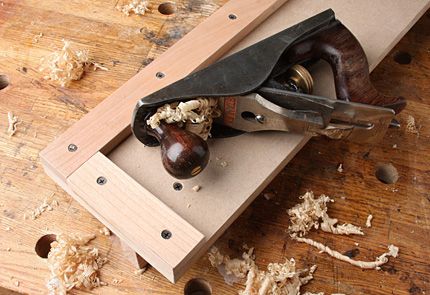How to Build and Use a Plane Stop for Narrow Parts

When it comes to handplaning, most folks turn to the trusty plane stop to secure their workpieces while planing toward the stop. While this works just fine in most cases, every once in a while, you’ll have to run your handplane along a piece of narrow stock that’s going to want to wobble left and right as your handplane travels along its surface.
When handplaning narrow stock, a plane stop with a fence on the far end and along one side will keep your workpieces from moving, and ensure more precise, uninterrupted passes.
|
More from Michael Pekovich |
In this video Quick Cut, Fine Woodworking art director Michael Pekovich demonstrates how to build and use a simple plane stock for narrow workpieces.
Build a Plane Stop for Narrow Workpieces


















Comments
Hey, that looks suspiciously identical to a planing tray I made about a year and a half ago, for working on chair parts.
Have you guys been sneaking into my shop? ;-)
I posted a photo of mine, in flagrante delicto, here: http://www.dendroica.com/Scratch/planingTray.jpg
-Steve
Hi Mike,
I use a similar jig but I like the long border on my left side, i.e, on the outer side of the bench. Since I am right handed, I tend to skew the plane like you do - the front of the plane is to my left. The wood tends to move to the left and thus against the border.
This also keeps the work piece as close as possible to my right hip, which I find more comfortable. This minimizes leaning over to reach the wood. The border piece is very narrow for the same reason. It also thus allows me to design the jig wider and use it for a greater range of work pieces.
I guess two borders is another option.
I secure the jig on the right side of the bench, between bench dogs, which keeps the front vise out of my way.
These are just personal preferences, I guess it depends on personal ergonomics, but readers may want to experiment with these different options and see what works best. I find planing is less fatiguing with my right hip as close to the plane as possible.
Rob
Thanks Rob, I had never thought of trying the fence on the near side. I can't remember having a problem with the work piece coming away from the fence, but you're right, I do tend to skew the plane in that direction.
I used to do a lot of planing on my old tablesaw outfeed table. It didn't have a vise, so I just screwed stops right to the tabletop. It worked pretty well.
-Mike
I found the video interesting however, shame on you for setting your plane on the sole when you finished your passes. I was taught to lay my plane on its side when the blade is extended. Sam
@sshanman--So, why do you think it is important to lay a plane on its side? Is it to protect the blade? If the answer is yes, can you please explain why? Plane blades are intentionally and forcefully driven into a piece of wood to cut the wood. Setting it the plane on a workbench made of much softer material doesn't seem, at least on its face, to be a big deal.
No, Michael's is totally different. He used black screws in his.
Log in or create an account to post a comment.
Sign up Log in